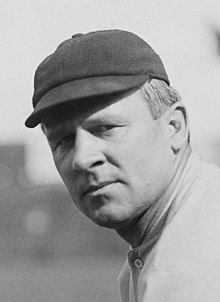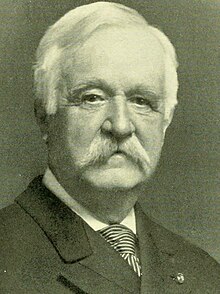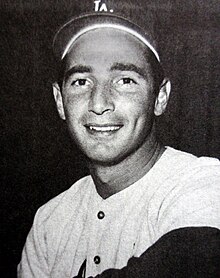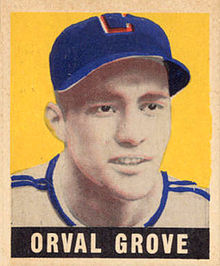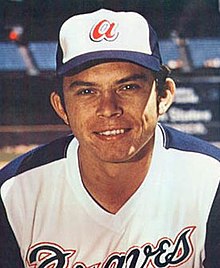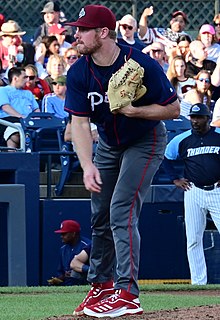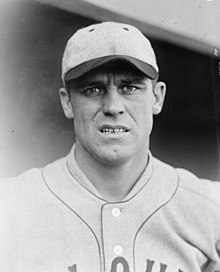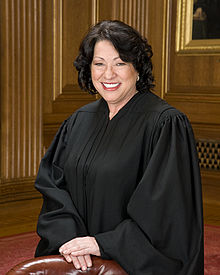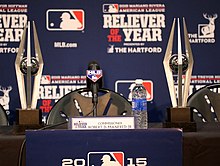Portal:Baseball
Portal maintenance status: (June 2018)
|
| Main page | Content, Categories & Topics | WikiProjects & Things you can do |
The Baseball Portal
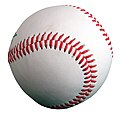
Baseball is a bat-and-ball sport played between two teams of nine players each, taking turns batting and fielding. The game occurs over the course of several plays, with each play generally beginning when a player on the fielding team, called the pitcher, throws a ball that a player on the batting team, called the batter, tries to hit with a bat. The objective of the offensive team (batting team) is to hit the ball into the field of play, away from the other team's players, allowing its players to run the bases, having them advance counter-clockwise around four bases to score what are called "runs". The objective of the defensive team (referred to as the fielding team) is to prevent batters from becoming runners, and to prevent runners advancing around the bases. A run is scored when a runner legally advances around the bases in order and touches home plate (the place where the player started as a batter).
The opposing teams switch back and forth between batting and fielding; the batting team's turn to bat is over once the fielding team records three outs. One turn batting for each team constitutes an inning. A game is usually composed of nine innings, and the team with the greater number of runs at the end of the game wins. Most games end after the ninth inning, but if scores are tied at that point, extra innings are usually played. Baseball has no game clock, though some competitions feature pace-of-play regulations such as the pitch clock to shorten game time.
Baseball evolved from older bat-and-ball games already being played in England by the mid-18th century. This game was brought by immigrants to North America, where the modern version developed. Baseball's American origins, as well as its reputation as a source of escapism during troubled points in American history such as the American Civil War and the Great Depression, have led the sport to receive the moniker of "America's Pastime"; since the late 19th century, it has been unofficially recognized as the national sport of the United States, though in modern times is considered less popular than other sports, such as American football. In addition to North America, baseball spread throughout the rest of the Americas and the Asia–Pacific in the 19th and 20th centuries, and is now considered the most popular sport in parts of Central and South America, the Caribbean, and East Asia, particularly in Japan, South Korea, and Taiwan. (Full article...)
 Featured articles - load new batch
Featured articles - load new batch
-
Image 1

WSNS-TV (channel 44) is a television station in Chicago, Illinois, United States, serving as the local outlet for the Spanish-language network Telemundo. It is owned and operated by NBCUniversal's Telemundo Station Group alongside NBC outlet WMAQ-TV (channel 5). The two stations share studios at the NBC Tower on North Columbus Drive in the city's Streeterville neighborhood and broadcast from the same transmitter atop the Willis Tower in the Chicago Loop.
WSNS-TV began broadcasting in 1970. Originally specializing in the automated display of news headlines, it evolved into Chicago's third full-fledged independent station, carrying movies, local sports, and other specialty programming. This continued until 1980, when WSNS became the Chicago-area station for ON TV, an over-the-air subscription television (STV) service owned by Oak Industries, which took a minority ownership stake in the station. While ON TV was successful in Chicago and the subscription system became the second-largest in the country by total subscribers, the rise of cable television precipitated the end of the business in 1985, with WSNS-TV as the last ON TV station standing. (Full article...) -
Image 2
Herschel Greer Stadium was a Minor League Baseball park in Nashville, Tennessee, on the grounds of Fort Negley, an American Civil War fortification, approximately two mi (3.2 km) south of the city's downtown district. The facility closed at the end of the 2014 baseball season and remained deserted for over four years until its demolition in 2019. Following an archaeological survey, the land is expected to be reincorporated into Fort Negley Park.
Greer was opened in 1978 for the Nashville Sounds, an expansion franchise of the Double-A Southern League who moved to the Triple-A American Association in 1985 and to the Triple-A Pacific Coast League in 1998. The stadium played host to the team until 2014. The subject of numerous upgrades and repairs to maintain its functionality, Greer became one of the oldest stadiums used by a Triple-A team and had fallen well below professional baseball's standards for a stadium at that class level by the end of its use. For over a decade, the Sounds attempted to secure agreements with the Metropolitan Government of Nashville and Davidson County for a new ballpark to replace Greer, eventually resulting in the construction of First Tennessee Park, which became the Sounds' new home in 2015. (Full article...) -
Image 3

Ichiro Suzuki was the first high-profile NPB player (second overall) to use the posting system.
The posting system (ポスティングシステム, posutingu shisutemu) is a baseball player transfer system that operates between Nippon Professional Baseball (NPB) and Major League Baseball (MLB). Despite the drafting of the United States – Japanese Player Contract Agreement, unveiled in 1967 to regulate NPB players moving to MLB, problems began to arise in the late 1990s. Some NPB teams lost star players without compensation, an issue highlighted when NPB stars Hideo Nomo and Alfonso Soriano left to play in MLB after using loopholes to void their existing contracts. A further problem was that NPB players had very little negotiating power if their teams decided to deal them to MLB, as when pitcher Hideki Irabu was traded to an MLB team for which he had no desire to play. In 1998, the Agreement was rewritten to address both problems; the result was dubbed the "posting system".
Under this system, when an NPB player is "posted", his NPB team notifies the MLB Commissioner, with the posting fee based on the type of contract a player signs and its value. For minor-league contracts, the fee is a flat 25% of contract's value; for MLB contracts, the fee is based on the value of the contract that the posted player eventually signs. The player is then given 30 days to negotiate with any MLB team willing to pay the NPB team's posting fee. If the player agrees on contract terms with a team before the 30-day period has expired, the NPB team receives the posting fee from the signing MLB team as a transfer fee, and the player is free to play in MLB. If no MLB team comes to a contract agreement with the posted player, then no fee is paid, and the player's rights revert to his NPB team. The current process replaced one in which MLB held a silent auction during which MLB teams submitted sealed, uncapped bids in an attempt to win the exclusive negotiating rights with the posted player for a period of 30 days. Once the highest bidding MLB team was determined, the player could then only negotiate with that team. (Full article...) -
Image 4
John Joseph McGraw (April 7, 1873 – February 25, 1934) was an American Major League Baseball (MLB) player and manager who was for almost thirty years manager of the New York Giants. He was also the third baseman of the pennant-winning 1890s Baltimore Orioles teams, noted for their innovative, aggressive play.
McGraw was born into poverty in Truxton, New York. He found an escape from his hometown and a bad family situation through baseball, beginning a quick rise through the minor leagues that led him to the Orioles at the age of 18. Under the tutelage of manager Ned Hanlon, the Orioles of the 1890s won three National League (NL) pennants; McGraw was one of the stalwarts of the team alongside Wee Willie Keeler, Hughie Jennings, and Wilbert Robinson. The Orioles perfected the hit and run play and popularized the Baltimore chop; they also sought to win by intimidating the opposing team and the umpire. (Full article...) -
Image 5
Derek Sanderson Jeter (/ˈdʒiːtər/ JEE-tər; born June 26, 1974), nicknamed "the Captain", is an American former professional baseball shortstop, businessman, and baseball executive. As a player, Jeter spent his entire 20-year Major League Baseball (MLB) career with the New York Yankees. He was elected to the Baseball Hall of Fame in his first year of eligibility in 2020; he received 396 of 397 possible votes, the second-highest percentage in MLB history (behind only teammate Mariano Rivera) and the highest by a position player. He was the chief executive officer (CEO) and part owner of the league's Miami Marlins from September 2017 to February 2022.
A five-time World Series champion with the Yankees, Jeter is regarded as a central contributor to the franchise's dynasty during the late 1990s and early 2000s for his hitting, base-running, fielding, and leadership. He is the Yankees' all-time career leader in hits (3,465), doubles (544), games played (2,747), stolen bases (358), times on base (4,716), plate appearances (12,602) and at bats (11,195). His accolades include 14 All-Star selections, five Gold Glove Awards, five Silver Slugger Awards, two Hank Aaron Awards, and a 2009 Roberto Clemente Award. Jeter was the 28th player to reach 3,000 hits and finished his career ranked sixth in MLB history in career hits and first among shortstops. In 2017, the Yankees retired his uniform number 2. (Full article...) -
Image 6Los Angeles Angels center fielder Mike Trout hits a home run on a pitch from New York Mets pitcher Tommy Milone on May 21, 2017.
Baseball is a bat-and-ball sport played between two teams of nine players each, taking turns batting and fielding. The game occurs over the course of several plays, with each play generally beginning when a player on the fielding team, called the pitcher, throws a ball that a player on the batting team, called the batter, tries to hit with a bat. The objective of the offensive team (batting team) is to hit the ball into the field of play, away from the other team's players, allowing its players to run the bases, having them advance counter-clockwise around four bases to score what are called "runs". The objective of the defensive team (referred to as the fielding team) is to prevent batters from becoming runners, and to prevent runners advancing around the bases. A run is scored when a runner legally advances around the bases in order and touches home plate (the place where the player started as a batter).
The initial objective of the batting team is to have a player reach first base safely; this generally occurs either when the batter hits the ball and reaches first base before an opponent retrieves the ball and touches the base, or when the pitcher persists in throwing the ball out of the batter's reach. Players on the batting team who reach first base without being called "out" can attempt to advance to subsequent bases as a runner, either immediately or during teammates' turns batting. The fielding team tries to prevent runs by using the ball to get batters or runners "out", which forces them out of the field of play. The pitcher can get the batter out by throwing three pitches which result in strikes, while fielders can get the batter out by catching a batted ball before it touches the ground, and can get a runner out by tagging them with the ball while the runner is not touching a base. (Full article...) -
Image 7
Morgan Gardner Bulkeley (December 26, 1837 – November 6, 1922) was an American politician of the Republican Party, businessman, and insurance executive. In 1876, he served as the first president of baseball's National League and, because of that, was inducted into the National Baseball Hall of Fame in 1937, a choice that remains controversial, since his time as a baseball executive was short.
Bulkeley was born in East Haddam, Connecticut. His father was Judge Eliphalet Adams Bulkeley, a prominent local lawyer and businessman, who became the first president of the Aetna Life Insurance Company. The family moved to Hartford, where Morgan Bulkeley was educated, before he took a job in the city of Brooklyn, New York. He served briefly in the American Civil War, where he saw no combat. When his father died in 1872, he moved back to Hartford and became a bank president and a board member of Aetna, becoming its president in 1879, a post he held the rest of his life. (Full article...) -
Image 8
Thurman Lowell Tucker (September 26, 1917 – May 7, 1993) was an American professional baseball player. A center fielder, Tucker played in Major League Baseball for nine seasons in the American League with the Chicago White Sox and Cleveland Indians. In 701 career games, Tucker recorded a batting average of .255 and accumulated 24 triples, nine home runs, and 179 runs batted in (RBI). Due to his resemblance of the film comedian Joe E. Brown, Tucker was nicknamed "Joe E.".
Born and raised in Texas, Tucker first played professionally with the Siloam Springs Travelers. After gradually progressing through minor league baseball, he signed with the Chicago White Sox before the 1941 season. His major league debut came the following year and he spent two years as the White Sox's starting center fielder until he enlisted in the armed forces during World War II. Upon his return, Tucker played two more seasons for the White Sox. Subsequently, he was traded to the Cleveland Indians, for whom he played four years, and continued to play minor league baseball throughout the 1950s. After his retirement, he became a major league scout and insurance agent. (Full article...) -
Image 9

Hershiser pitching for the Dodgers in 1993
During the 1988 Major League Baseball season, pitcher Orel Hershiser of the Los Angeles Dodgers set the MLB record for consecutive scoreless innings pitched. Over 59 consecutive innings, opposing hitters did not score a run against Hershiser. During the streak, he averted numerous high-risk scoring situations. The streak spanned from the sixth inning of an August 30 game against the Montreal Expos to the 10th inning of a September 28 game against the San Diego Padres. The previous record of 58+2⁄3 innings was set by former Dodger pitcher Don Drysdale in 1968; as the team's radio announcer, Drysdale called Hershiser's streak as he pursued the new record. Pundits have described the streak as among the greatest records in baseball history, with one pundit ranking it among the greatest individual feats in American sports.
During the streak, the Elias Sports Bureau changed its criteria for the official consecutive scoreless innings record for starting pitchers from including fractional innings in which one or two outs had been recorded to counting only complete scoreless innings. Since the streak was active at the end of the 1988 season, it could have spanned two separate seasons. However, Hershiser yielded a run in his first inning of work in the 1989 season against the Cincinnati Reds, thus ending the streak at 59 consecutive scoreless innings pitched. The streak includes only innings pitched in the regular season, excluding eight scoreless innings Hershiser pitched to start Game 1 of the 1988 National League Championship Series on October 4 (unofficially extending his streak to 67 combined innings). Although he completed the ninth inning in each start, the streak's final game lasted 16 innings, of which he pitched only the first 10. Thus, Hershiser did not match Drysdale's record of six consecutive complete game shutouts. Like Drysdale's streak, the penultimate game of Hershiser's streak was a Dodgers–Giants game that featured a controversial umpire's ruling that saved the streak. (Full article...) -
Image 10
Mariano Rivera (born November 29, 1969) is a Panamanian-American former professional baseball pitcher who played 19 seasons in Major League Baseball (MLB) for the New York Yankees, from 1995 to 2013. Nicknamed "Mo" and "Sandman", he spent most of his career as a relief pitcher and served as the Yankees' closer for 17 seasons. A thirteen-time All-Star and five-time World Series champion, he is MLB's career leader in saves (652) and games finished (952). Rivera won five American League (AL) Rolaids Relief Man Awards and three Delivery Man of the Year Awards, and he finished in the top three in voting for the AL Cy Young Award four times. In 2019, he was inducted into the Baseball Hall of Fame in his first year of eligibility, and is to date the only player ever to be elected unanimously by the Baseball Writers' Association of America (BBWAA).
Raised in the modest Panamanian fishing village of Puerto Caimito, Rivera was an amateur player until he was signed by the Yankees organization in 1990. He debuted in the major leagues in 1995 as a starting pitcher, before permanently converting to a relief pitcher late that year. After a breakthrough season in 1996 as a setup man, he became the Yankees' closer in 1997. In the following seasons, he established himself as one of baseball's top relievers, leading the major leagues in saves in 1999, 2001, and 2004. Rivera primarily threw a sharp-moving, mid-90s mile-per-hour cut fastball that frequently broke hitters' bats and earned a reputation as one of the league's toughest pitches to hit. With his presence at the end of games, signaled by his foreboding entrance song "Enter Sandman", Rivera was a key contributor to the Yankees' dynasty in the late 1990s and early 2000s that won four championships in five years. He was an accomplished postseason performer, winning the 1999 World Series Most Valuable Player (MVP) Award and the 2003 AL Championship Series MVP Award, while setting postseason records that included lowest earned run average (ERA) (0.70) and most saves (42). (Full article...) -
Image 11
Sanford Koufax (/ˈkoʊfæks/; né Braun; born December 30, 1935), nicknamed "the Left Arm of God", is an American former baseball pitcher who played 12 seasons in Major League Baseball (MLB) for the Brooklyn/Los Angeles Dodgers from 1955 to 1966. Widely regarded as one of the greatest pitchers in baseball history, Koufax was the first three-time winner of the Cy Young Award, each time winning unanimously and the only pitcher to do so when a single award was given for both the leagues; he was also named the National League Most Valuable Player in 1963. Retiring at the age of 30 due to chronic pain in his pitching elbow, Koufax was elected to the Baseball Hall of Fame in his first year of eligibility in 1972 at the age of 36, the youngest player ever elected.
Born in Brooklyn, New York, Koufax was primarily a basketball player in his youth and had pitched in only a few games before signing with the Brooklyn Dodgers at age 19. Due to the bonus rule he signed under, Koufax never pitched in the minor leagues. His lack of pitching experience caused manager Walter Alston to distrust Koufax, who saw inconsistent playing time during his first six seasons. As a result, though he often showed flashes of brilliance, Koufax struggled early on. Frustrated with the way he was being managed by the Dodgers, he almost quit after the 1960 season. After making adjustments prior to the 1961 season, Koufax quickly rose to become the most dominant pitcher in the major leagues, as well as the first major sports star on the West Coast. He was an All-Star in each of his last six seasons, leading the National League (NL) in earned run average each of his last five years, in strikeouts four times, and in wins and shutouts three times each. He was the first pitcher in the live-ball era to post an earned run average below 2.00 in three different qualifying seasons, and the first ever to record a 300-strikeout season three times. (Full article...) -
Image 12

Ian Michael Chappell (born 26 September 1943) is a former cricketer who played for South Australia and Australia. Known as "Chappelli", he is considered as one of the greatest captains the game has seen. He captained Australia between 1971 and 1975 before taking a central role in the breakaway World Series Cricket organisation. Born into a cricketing family—his grandfather and brother also captained Australia—Chappell made a hesitant start to international cricket playing as a right-hand middle-order batsman and spin bowler. He found his niche when promoted to bat at number three. Chappell's blunt verbal manner led to a series of confrontations with opposition players and cricket administrators; the issue of sledging first arose during his tenure as captain, and he was a driving force behind the professionalisation of Australian cricket in the 1970s. He was the captain of the Australian squad which finished as runners-up at the 1975 Cricket World Cup.
John Arlott called him "a cricketer of effect rather than the graces". An animated presence at the batting crease, he constantly adjusted his equipment and clothing, and restlessly tapped his bat on the ground as the bowler ran in. Basing his game on a sound defence learned during many hours of childhood lessons, Chappell employed the drive and square cut to full effect. He had an idiosyncratic method of playing back and across to a ball of full length and driving wide of mid-on, but his trademark shot was the hook, saying "three bouncers an over should be worth 12 runs to me". A specialist slip fielder, he was the fourth player to take one hundred Test catches. (Full article...) -
Image 13
Orval Leroy Grove (August 29, 1919 – April 20, 1992) was an American professional baseball pitcher in Major League Baseball who played for ten seasons in the American League with the Chicago White Sox. In 207 career games, Grove pitched 1,176 innings and posted a win–loss record of 63–73, with 66 complete games, 11 shutouts, and a 3.78 earned run average (ERA).
The only freshman on the Proviso Township High School varsity baseball team, Grove's pitching ability attracted the attention of the White Sox. After signing with the team in 1937, Grove moved between the major leagues and minor leagues for a few seasons until 1943, when he found a solid place in the White Sox's pitching rotation. Grove had a career-year in 1943, finishing the season with career-bests in ERA, wins, and complete games; in 1944, he made his only All-Star appearance. (Full article...) -
Image 14
Arthur Joseph Houtteman (August 7, 1927 – May 6, 2003) was an American right-handed pitcher in Major League Baseball who played for 12 seasons in the American League with the Detroit Tigers, Cleveland Indians and Baltimore Orioles. In 325 career games, Houtteman pitched 1,555 innings and posted a win–loss record of 87–91, with 78 complete games, 14 shutouts, and a 4.14 earned run average (ERA).
Known on the sandlot for his pitching motion, Houtteman was signed by scout Wish Egan in 1945 at 17 years of age. He was recruited by major league teams, and joined a Tigers pitching staff that had lost players to injuries and World War II. After moving between the major and minor leagues over the next few years, he was nearly killed in an automobile accident just before the 1949 season. Houtteman rebounded from his injuries and went on to win 15 games that season and made his only All-Star appearance in the following year. (Full article...) -
Image 15
Harmon Clayton Killebrew Jr. (/ˈkɪlɪbruː/; June 29, 1936 – May 17, 2011), nicknamed "the Killer" and "Hammerin' Harmon", was an American professional baseball first baseman, third baseman, and left fielder. He spent most of his 22-year career in Major League Baseball (MLB) with the Minnesota Twins. A prolific power hitter, Killebrew had the fifth-most home runs in major league history at the time of his retirement. He was second only to Babe Ruth in American League (AL) home runs, and was the AL career leader in home runs by a right-handed batter. Killebrew was inducted into the National Baseball Hall of Fame in 1984.
Killebrew was 5-foot-11-inch (180 cm) tall and 213 pounds (97 kg). His compact swing generated tremendous power and made him one of the most feared power hitters of the 1960s, when he hit at least 40 home runs per season eight times. In total Killebrew led the league six times in home runs and three times in RBIs, and was named to 13 All-Star teams. In 1965, he played in the World Series with the Twins, who lost to the Los Angeles Dodgers. His finest season was 1969, when he hit 49 home runs, recorded 140 RBIs and won the AL Most Valuable Player Award while helping lead the Twins to the AL West pennant. (Full article...)
General images - load new batch
-
Image 1The typical motion of a right-handed pitcher (from Baseball rules)
-
Image 2A batter follows through after swinging at a pitched ball. (from Baseball rules)
-
Image 4A game from the Cantigas de Santa Maria, c. 1280, involving tossing a ball, hitting it with a stick and competing with others to catch it (from History of baseball)
-
Image 5Jackie Robinson in 1945, with the era's Kansas City Royals, a barnstorming squad associated with the Negro American League's Kansas City Monarchs (from History of baseball)
-
Image 6The NL champion New York Giants baseball team, 1913. Fred Merkle, sixth in line, had committed a baserunning gaffe in a crucial 1908 game that became famous as Merkle's Boner. (from History of baseball)
-
Image 7By the 1860s Civil War, baseball (bottom) had overtaken its fellow bat-and-ball sport cricket (top) in popularity within the United States. (from History of baseball)
-
Image 82013 World Baseball Classic championship match between the Dominican Republic and Puerto Rico, March 20, 2013 (from Baseball)
-
Image 9Pesäpallo, a Finnish variation of baseball, was invented by Lauri "Tahko" Pihkala in the 1920s, and after that, it has changed with the times and grown in popularity. Picture of Pesäpallo match in 1958 in Jyväskylä, Finland. (from Baseball)
-
Image 12Rickey Henderson—the major leagues' all-time leader in runs and stolen bases—stealing third base in a 1988 game (from Baseball)
-
Image 13The American Tobacco Company's line of baseball cards featured shortstop Honus Wagner of the Pittsburgh Pirates from 1909 to 1911. In 2007, the card shown here sold for $2.8 million. (from Baseball)
-
Image 15An Afghan girl playing baseball in August 2002 (from Baseball)
-
Image 16In May 2010, the Philadelphia Phillies' Roy Halladay pitched the 20th major league perfect game. That October, he pitched only the second no-hitter in MLB postseason history. (from History of baseball)
-
Image 17Alexander Cartwright, father of modern baseball (from History of baseball)
-
Image 18Baserunners generally stand a short distance away from their base between pitches, preparing themselves to either go back or steal the next base. (from Baseball rules)
-
Image 19The standard fielding positions (from Baseball rules)
-
Image 21A New York Yankees batter (Andruw Jones) and a Boston Red Sox catcher at Fenway Park (from Baseball)
-
Image 22Baseball games sometimes end in a walk-off home run, with the batting team usually gathering at home plate to celebrate the scoring of the winning run(s). (from Baseball rules)
-
Image 23A pitcher handing off the ball after being taken out of the game during a mound meeting. (from Baseball)
-
Image 24Pick-off attempt on runner (in red) at first base (from Baseball rules)
-
Image 27Sadaharu Oh managing the Japan national team in the 2006 World Baseball Classic. Playing for the Central League's Yomiuri Giants (1959–80), Oh set the professional world record for home runs. (from Baseball)
-
Image 28A well-worn baseball (from Baseball)
-
Image 29Cover of Official Base Ball Rules, 1921 edition, used by the American League and National League (from Baseball rules)
-
Image 30Pitchers are generally substituted during mound visits (team gatherings at the pitcher's mound). (from Baseball rules)
-
Image 31Fenway Park, home of the Boston Red Sox. The Green Monster is visible beyond the playing field on the left. (from Baseball)
-
Image 32Japanese-Americans spectating a World War II-era game while in an internment camp. America's ties to immigrants and to Japan have been deeply shaped by a shared baseball heritage. (from History of baseball)
-
Image 33A runner sliding into home plate and scoring. (from Baseball)
-
Image 34Diagram of a baseball field Diamond may refer to the square area defined by the four bases or to the entire playing field. The dimensions given are for professional and professional-style games. Children often play on smaller fields. (from Baseball)
-
Image 35The strike zone determines the result of most pitches, and varies in vertical length for each batter. (from Baseball)
-
Image 361906 World Series, infielders playing "in" for the expected bunt and the possible play at the plate with the bases loaded (from Baseball rules)
-
Image 37The strike zone, which determines the outcome of most pitches, varies in vertical length depending on the batter's typical height while swinging. (from Baseball rules)
-
Image 40Sadaharu Oh managing the Japan national team in the 2006 World Baseball Classic. Playing for the Central League's Yomiuri Giants (1959–80), Oh set the professional world record for home runs with 868. (from History of baseball)
-
Image 41Jackie Robinson in 1945, with the era's Kansas City Royals, a barnstorming squad associated with the Negro American League's Kansas City Monarchs (from Baseball)
-
Image 42Defensive positions on a baseball field, with abbreviations and scorekeeper's position numbers (not uniform numbers) (from Baseball)
-
Image 43Cy Young—the holder of many major league career marks, including wins and innings pitched, as well as losses—in 1908. MLB's annual awards for the best pitcher in each league are named for Young. (from Baseball)
-
Image 45A first baseman receives a pickoff throw, as the runner dives back to first base. (from Baseball)
 Good articles - load new batch
Good articles - load new batch
-
Image 1
Darrell Wayne Evans (born May 26, 1947) is an American former baseball player, coach and manager. He played 21 seasons in Major League Baseball (MLB), beginning his career as a third baseman with the Atlanta Braves (1969–1976, 1989), alternating between first and third base with the San Francisco Giants (1976–1983), and playing much of his later career as a first baseman and then a designated hitter for the Detroit Tigers (1984–1988). He won a World Series championship with the Tigers in 1984. Evans had most of his success in the early and late stages of his career. He was a two-time All-Star, first with the Braves in 1973 and then with the Giants in 1983. He led MLB in home runs in 1985 with the Tigers, and walks in 1973 and 1974 with the Braves.
Born in Pasadena, California, Evans was the son of a professional fast pitch softball player. He attended Pasadena City College and helped lead the baseball and basketball teams to California junior college championships. In the majors, Evans had a breakout season in 1973, finishing third in MLB with 41 home runs and leading the league in runs created and walks. He was traded to the San Francisco Giants in the middle of his lackluster 1976 season. His best season with the Giants was his 1983 All-Star season when he hit 30 home runs and compiled a .378 on-base percentage in his last year with the team. Evans signed as a free agent with the Detroit Tigers prior to the 1984 season, winning the World Series in his first year with the team. He led MLB in home runs in 1985 at age 38, becoming the oldest player in history to accomplish the feat. By hitting his home runs in the American League, he also became the first in MLB history to have a 40-homer season in both the American and the National Leagues. Evans concluded his playing career with a return to the Braves in 1989. (Full article...) -
Image 2Falter with the Lehigh Valley IronPigs in 2022
Bailey Falter (born April 24, 1997) is an American professional baseball pitcher for the Pittsburgh Pirates of Major League Baseball (MLB). He previously played in MLB for the Philadelphia Phillies.
Born in Chino Hills, California, Falter grew up idolizing pitcher Sandy Koufax. He attended Chino Hills High School, pitching a no-hitter for their baseball team in 2013. The Phillies selected Falter in the fifth round of the 2015 MLB draft, and he signed with the team that year. His rise through the Phillies' farm system was disrupted by an elbow injury in 2019 and the subsequent cancellation of the 2020 minor league season. Falter made his MLB debut with the Phillies in 2021, and he spent the next three seasons alternating between Philadelphia and the Triple-A Lehigh Valley IronPigs, serving as both a starting pitcher and a reliever. The Pirates acquired Falter in 2023, adding him to their starting rotation. (Full article...) -
Image 3
Vincent John Velasquez (/vəˈlɑːskɛz/ veh-LAS-kehz; born June 7, 1992) is an American professional baseball pitcher who is a free agent. He has played in Major League Baseball (MLB) for the Houston Astros, Philadelphia Phillies, San Diego Padres, Chicago White Sox, and Pittsburgh Pirates.
Born in Montclair, California, Velasquez was a multi-sport athlete at Garey High School in Pomona. After bone spurs in his right elbow kept him from pitching and playing shortstop, he learned how to field left-handed. A growth spurt prior to his senior year of high school caused him to draw interest from the soccer and gridiron football teams, but Velasquez opted to focus on baseball on the advice of a scout for the Chicago White Sox. The Astros selected him in the second round of the 2010 MLB Draft, and Velasquez chose to pitch for them rather than honor his commitment to play college baseball as a shortstop for Cal State Fullerton. He was assigned to the Greeneville Astros in 2010, but underwent Tommy John surgery later that year and did not return to the field until 2012. He had a successful season with the Quad Cities River Bandits in 2013, but struggles during a three-game stretch with the Lancaster JetHawks inspired him to sharpen his curveball. The following year, he helped take the JetHawks to a California League championship title. (Full article...) -
Image 4Julie Croteau (born December 4, 1970) is an American former college and professional baseball player. She is recognized as the first woman to regularly play men's National Collegiate Athletic Association (NCAA) baseball, as well as the first woman to coach men's NCAA Division I baseball and one of the first women to play in a Major League Baseball-sanctioned league.
Croteau attended Osbourn Park High School in Manassas, Virginia, where she and her parents filed a sex discrimination lawsuit against the school to play baseball on the men's team, which she lost. In college, Croteau, a first basewoman, had a .222 batting average her freshman year as the St. Mary's College of Maryland Seahawks finished with a 1–20–1 win–loss–tie record. In 1994, she played for the all-women Colorado Silver Bullets in their inaugural season, where she batted .078 against semi-professional male competition; after the year, she played for the Maui Stingrays of the Hawaii Winter Baseball league. Her baseball glove and photo are on display at the National Baseball Hall of Fame and Museum in Cooperstown, New York. As of 2024[update], Croteau was on the staff of Stanford University. (Full article...) -
Image 5Anderson with the Lehigh Valley IronPigs in 2021
Robert Chase Anderson (born November 30, 1987) is an American professional baseball pitcher who is a free agent. He has previously played in Major League Baseball (MLB) for the Arizona Diamondbacks, Milwaukee Brewers, Toronto Blue Jays, Philadelphia Phillies, Cincinnati Reds, Tampa Bay Rays, Colorado Rockies, Boston Red Sox, and Texas Rangers.
Anderson was born in Wichita Falls, Texas, and helped his father with the family business following his parents' divorce. He was a standout pitcher at S. H. Rider High School, pitching three no-hitters as a senior in 2006 and setting a school record for career strikeouts, but his slender build limited attention from college baseball recruiters. He spent two seasons with North Central Texas College before transferring to the University of Oklahoma for the 2009 season. The Diamondbacks selected Anderson in the ninth round of the 2009 MLB Draft. He spent the next several years rising through the team's farm system, suffering a setback in 2011 when an elbow injury caused him to miss nearly the entire season. Anderson made his major league debut for the Diamondbacks in 2014. (Full article...) -
Image 6
Edward Grant Barrow (May 10, 1868 – December 15, 1953) was an American manager and front office executive in Major League Baseball. He served as the field manager of the Detroit Tigers and Boston Red Sox. He served as business manager (de facto general manager) of the New York Yankees from 1921 to 1939 and as team president from 1939 to 1945, and is credited with building the Yankee dynasty. Barrow was elected to the Baseball Hall of Fame in 1953.
Born in a covered wagon in Springfield, Illinois, Barrow worked as a journalist and soap salesman before entering the business of baseball by selling concessions at games. From there, Barrow purchased minor league baseball teams, also serving as team manager, and served as president of the Atlantic League. After managing the Tigers in 1903 and 1904 and returning to the minor leagues, Barrow became disenchanted with baseball, and left the game to operate a hotel. (Full article...) -
Image 7Charles William "Butch" Wensloff (December 3, 1915 – February 18, 2001) was an American right-handed pitcher in Major League Baseball who played for three seasons in the American League with the New York Yankees and Cleveland Indians. In 41 career games, Wensloff pitched 276+2⁄3 innings and posted a win–loss record of 16–13 and a 2.60 earned run average (ERA).
Wensloff began his career in the Arizona–Texas League before joining the New York Yankees farm system. He played on various minor league teams for the next six seasons and made his debut during the 1943 New York Yankees season. He pitched in 29 games, and after the season ended, he served in the United States Army during World War II. Wensloff rejoined the Yankees in 1947, pitching in 11 regular-season games and in the 1947 World Series. After the season ended, he was sent to the Cleveland Indians and pitched in one game for the team before retiring at the end of the season. (Full article...) -
Image 8Jeffrey Bryan Hammonds (born March 5, 1971) is an American former professional baseball player. Hammonds was an outfielder and played for the Baltimore Orioles (1993–1998), Cincinnati Reds (1998–1999), Colorado Rockies (2000), Milwaukee Brewers (2001–2003), San Francisco Giants (2003–2004) and the Washington Nationals (2005) in Major League Baseball (MLB). Before playing professionally, Hammonds played for Scotch Plains-Fanwood High School in Scotch Plains, New Jersey and Stanford University.
At Stanford, Hammonds was named an All-American. The Orioles selected Hammonds with the fourth overall selection of the 1992 MLB Draft. Though he was seen as one of the best prospects in baseball, injuries limited his performance with Baltimore. After he was traded to Cincinnati and then to Colorado, he emerged with the Rockies in 2000, and was selected to appear at the 2000 Major League Baseball All-Star Game. He signed a three-year, $21.75 million contract with the Milwaukee Brewers that off-season, but continued to struggle with injuries. He had a resurgence with the Giants in 2003, after he was released by the Brewers, but struggled with the Giants in 2004 and Nationals in 2005 before retiring. (Full article...) -
Image 9
George Harold Sisler (March 24, 1893 – March 26, 1973), nicknamed "Gorgeous George", was an American professional baseball first baseman and player-manager. From 1915 through 1930, he played in Major League Baseball (MLB) for the St. Louis Browns, Washington Senators, and Boston Braves. He managed the Browns from 1924 through 1926.
Sisler played college baseball for the University of Michigan and was signed by the St. Louis Browns in 1915. He won the American League (AL) batting title in 1920 and 1922. In 1920, he batted .407 and recorded 257 hits, the record until Ichiro Suzuki had 262 in 2004. Sisler won the AL Most Valuable Player Award in 1922, finishing with a batting average of .420, the third-highest batting average by AL or NL players after 1900. An attack of sinusitis caused vision troubles that jeopardized Sisler's career, but he returned to playing in 1924, remaining in the major leagues through the 1930 season. After Sisler retired as a player, he worked as a major league scout and aide. (Full article...) -
Image 10
The 1995 American League West tie-breaker game was a one-game extension to Major League Baseball's (MLB) 1995 regular season; the California Angels and Seattle Mariners met to determine the winner of the American League's (AL) West Division. It was played at the Kingdome in Seattle, on October 2, 1995.
The game was necessary after both teams finished the strike-shortened 144-game season with identical records of 78–66 (.542). Scoreless until the fifth inning, Seattle held a slim 1–0 lead at the seventh-inning stretch. The Mariners then broke it open and won 9–1 to secure the franchise's first postseason berth. It was counted as the 145th regular season game for both teams, with all the events in the game added to regular season statistics. (Full article...) -
Image 11
Trevor William Hoffman (born October 13, 1967) is an American former professional baseball pitcher who played 18 years in Major League Baseball (MLB) from 1993 to 2010. A long-time closer, he pitched for the Florida Marlins, San Diego Padres, and Milwaukee Brewers, including more than 15 years for the Padres. Hoffman was the major leagues' first player to reach the 500- and 600-save milestones, and was the all-time saves leader from 2006 until 2011. The National League (NL) leader in career saves, he was inducted into the Baseball Hall of Fame in 2018. Hoffman currently serves as senior advisor for baseball operations for the Padres.
Hoffman played shortstop collegiately at the University of Arizona and was drafted in the 11th round by the Cincinnati Reds. After not having much success batting, he was converted to a pitcher, as he was able to throw up to 95 miles per hour (MPH). The Marlins acquired Hoffman in the 1992 expansion draft, and he pitched for Florida until he was traded to the Padres, mid-season in 1993, in a deal that sent star Gary Sheffield to the Marlins. Hoffman recorded 20 saves in 1994 in his first season as Padres closer, and in the following years, he became the face of the franchise after Tony Gwynn retired. Hoffman collected at least 30 saves each year for the next 14 years with San Diego, except for 2003 when he missed most of the year recovering from shoulder surgery. After the Padres did not re-sign him following the 2008 season, Hoffman pitched for two years with the Brewers before retiring after the 2010 season. (Full article...) -
Image 12
Sonia Maria Sotomayor (/ˈsoʊnjə ˌsoʊtoʊmaɪˈjɔːr/ ⓘ, Spanish: [ˈsonja sotomaˈʝoɾ]; born June 25, 1954) is an American lawyer and jurist who serves as an associate justice of the Supreme Court of the United States. She was nominated by President Barack Obama on May 26, 2009, and has served since August 8, 2009. She is the third woman, the first woman of color, the first Hispanic, and the first Latina to serve on the Supreme Court.
Sotomayor was born in the Bronx, New York City, to Puerto Rican-born parents. Her father died when she was nine, and she was subsequently raised by her mother. Sotomayor graduated summa cum laude from Princeton University in 1976 and received her Juris Doctor from Yale Law School in 1979, where she was an editor of the Yale Law Journal. Sotomayor worked as an assistant district attorney in New York for four and a half years before entering private practice in 1984. She played an active role on the boards of directors for the Puerto Rican Legal Defense and Education Fund, the State of New York Mortgage Agency, and the New York City Campaign Finance Board. (Full article...) -
Image 13
Edwin Collins "Alabama" Pitts Jr. (November 22, 1909 – June 7, 1941) was an American convicted felon who garnered media attention in his attempt to play professional baseball after his release from Sing Sing prison. While serving five years for robbing a grocery store at gunpoint, he played for the prison baseball and American football squads. After being denied the ability to play for the Albany Senators of the International League in 1935 by the president of the National Association of Professional Baseball Leagues, he appealed to Commissioner Kenesaw Mountain Landis, who granted his request.
Pitts went on to play for five years as a baseball player for the Albany Senators; York White Roses and Trenton Senators of the New York–Pennsylvania League; Charlotte Hornets, Gastonia Spinners, Valdese Textiles, and Lenoir Finishers of the Carolina League; Winston-Salem Twins of the Piedmont League; and Hickory Rebels of the Tar Heel League. He played football for two years, including one as a member of the National Football League's Philadelphia Eagles. Two films (The Billion Dollar Scandal and Over the Wall) produced in the 1930s were inspired by his life story, and he was fatally stabbed at a tavern in June 1941. (Full article...) -
Image 14Benjamin Raymond Geraghty (July 19, 1912 – June 18, 1963) was an American infielder in Major League Baseball and one of the most successful and respected minor league managers of the 1950s.
A Jersey City native, Geraghty went right from Villanova University to the 1936 Brooklyn Dodgers, appearing in 51 games with the team in his rookie season. He appeared in 19 more games with the Boston Braves over the 1943 and 1944 seasons, compiling a batting average of .199 in 146 at bats with 29 hits in 71 career games. In 1946, he survived a horrific bus crash that killed nine of his Spokane Indians teammates. (Full article...) -
Image 15
Donald Zackary Greinke (/ˈɡreɪnki/ GRAYN-kee; born October 21, 1983) is an American professional baseball pitcher who is a free agent. Greinke primarily played with the Kansas City Royals in Major League Baseball (MLB) across two stints; from his 2004 debut to 2010, and from 2022 to 2023. He has also played for the Milwaukee Brewers, Los Angeles Angels of Anaheim, Los Angeles Dodgers, Arizona Diamondbacks, and Houston Astros, with the last of which Greinke finished as a runner-up in the 2019 and 2021 World Series. Greinke is considered to be one of the greatest pitchers of his generation.
The Royals selected Greinke in the first round with the sixth pick of the 2002 MLB draft, after he won the Gatorade National Player of the Year Award as a high school senior. After playing in the minor leagues, he made his MLB debut in 2004. His career was nearly derailed by his battles with depression and anxiety in 2005 and 2006, and he missed most of the 2006 season. He returned in 2007 as a relief pitcher, before rejoining the starting rotation in 2008 and developing into one of the top pitchers in the game. In 2009, he appeared in the MLB All-Star Game, led the major leagues in earned run average, and won the American League Cy Young Award. (Full article...)
Did you know (auto-generated) - load new batch

- ... that Genevieve Beacom became the first woman to pitch in the Australian Baseball League when she made her debut for the Melbourne Aces in 2022?
- ... that Major League Baseball pitcher Charlie Gray was billed as his team's pitcher "of six fingers and six toed fame" and called "a freak" by the Sporting Life?
- ... that after the 1918 season, some Major League Baseball owners wanted the National Baseball Commission to be replaced by former president William Howard Taft?
- ... that Corky Palmer coached the Southern Miss Golden Eagles to their only College World Series appearance in 2009?
- ... that Major League Baseball player Wade Meckler was 4 feet 10 inches (1.47 metres) tall and weighed 75 pounds (34 kilograms) when he was a high-school freshman?
- ... that Bill Duplissea has been said to have the "best eyes in baseball"?
- ... that Brewer Hicklen hosts an annual youth baseball camp in Alabama?
- ... that Jenny Cavnar is the first female primary play-by-play announcer in Major League Baseball history?
Quotes
| "Baseball has been good to me since I quit trying to play it." |
 Featured lists - load new batch
Featured lists - load new batch
-
Image 1On November 17, 1992, during the 1992–93 offseason, Major League Baseball (MLB) held an expansion draft in New York City to allow two expansion teams, the Florida Marlins and Colorado Rockies, to build their rosters prior to debuting in the National League's (NL) East and West divisions, respectively, in the 1993 MLB season.
The 1990 collective bargaining agreement between MLB owners and the MLB Players Association allowed the NL to expand by two members to match the American League (AL). In June 1991, MLB accepted bids of groups from Miami, Florida, and Denver, Colorado, with debuts set for 1993. (Full article...) -
Image 2

Giancarlo Stanton holds 10 records for the Marlins franchise, the most of any Marlins player.
The Miami Marlins are a Major League Baseball (MLB) franchise based in the U.S. state of Florida. The Marlins became members of MLB as an expansion team in the 1993 season. Through 2017, they have played 3,981 games, winning 1,870 and losing 2,111 for a winning percentage of .470. This list documents the superlative records and accomplishments of team members during their tenures as Marlins in MLB's National League East.
Giancarlo Stanton holds the most franchise records as of the end of the 2018 season, with ten records, including both the most career and single-season home runs, RBI, slugging percentage, and total bases records. (Full article...) -
Image 3Lou Piniella won the 2008 National League Manager of the Year Award, and won twice in the American League.
In Major League Baseball, the Manager of the Year Award is an honor given annually since 1983 to two outstanding managers, one each in the American League (AL) and the National League (NL). The winner is voted on by 30 members of the Baseball Writers' Association of America (BBWAA). Each submits a vote for first, second, and third place among the managers of each league.[a] The manager with the highest score in each league wins the award.
Several managers have won the award in a season in which they led their team to 100 or more wins. They are:- Lou Piniella – 116 (Seattle Mariners, 2001)
- Joe Torre – 114 (New York Yankees, 1998)
- Gabe Kapler – 107 (San Francisco Giants, 2021)
- Sparky Anderson – 104 (Detroit Tigers, 1984)
- Tony La Russa – 104 (Oakland Athletics, 1988)
- Dusty Baker – 103 (San Francisco Giants, 1993)
- Larry Dierker – 102 (Houston Astros, 1998)
- Whitey Herzog – 101 (St. Louis Cardinals, 1985)
- Rocco Baldelli – 101 (Minnesota Twins, 2019)
- Buck Showalter – 101 (New York Mets, 2022)
- Brandon Hyde – 101 (Baltimore Orioles, 2023)
- Kevin Cash – 100 (Tampa Bay Rays, 2021)
-
Image 4

Babe Ruth was the first player to reach 500 home runs and set a career home run mark of 714 that stood until 1974.
In Major League Baseball (MLB), the 500 home run club is a group of batters who have hit 500 or more regular-season home runs in their careers. There are twenty-eight players who are members of the 500 home run club. Seven 500 home run club members—Hank Aaron, Willie Mays, Eddie Murray, Rafael Palmeiro, Albert Pujols, Alex Rodriguez and Miguel Cabrera—are also members of the 3,000 hit club.
In the past, membership in the 500 home run club was a guarantee of eventual entry into the Baseball Hall of Fame, although some believe the milestone has become less meaningful in recent years and many members have not been enshrined in Cooperstown. (Full article...) -
Image 5

Mark Teixeira (2001) played 162 games for the Rangers in back-to-back seasons and finished second in the MVP voting in 2009.
The Texas Rangers are a Major League Baseball (MLB) franchise based in the Dallas–Fort Worth metropolitan area. They play in the American League West division. Before 1972 (and for the first seven years of the draft), they were known as the Washington Senators and based in Washington, D.C. Since the institution of MLB's Rule 4 Draft, the Rangers franchise has selected 68 players in the first round. Officially known as the "First-Year Player Draft", the Rule 4 Draft is MLB's primary mechanism for assigning amateur baseball players from high schools, colleges, and other amateur baseball clubs to its teams. The draft order is determined based on the previous season's standings, with the team possessing the worst record receiving the first pick. In addition, teams which lost free agents in the previous off-season may be awarded compensatory or supplementary picks.
Of the 71 players picked in the first round by Washington or Texas, 37 have been pitchers, the most of any position; 27 of these were right-handed, while 10 were left-handed. Twelve outfielders, nine third basemen, six shortstops, four catchers, two first basemen, and one second baseman were also taken. Fourteen of the players came from high schools or colleges in the state of Texas, and California follows with ten players. The Rangers have drafted one player, Tanner Scheppers in 2009, who was playing in the American Association of Independent Professional Baseball at the time of the draft. Scheppers was originally drafted by the Baltimore Orioles in the 29th round of the 2005 MLB Draft, and by the Pittsburgh Pirates in the second round of the 2008 MLB Draft. (Full article...) -
Image 6
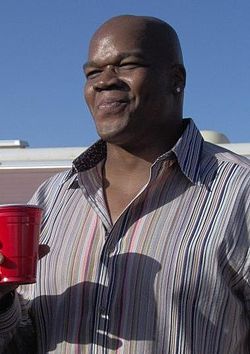
Frank Thomas (1989) was a two-time American League Most Valuable Player, and was a first-ballot Hall of Fame inductee in 2014.
The Chicago White Sox are a Major League Baseball (MLB) franchise based in Chicago, Illinois. They play in the American League Central division. Since the institution of MLB's Rule 4 Draft, the White Sox have selected 66 players in the first round. Officially known as the "First-Year Player Draft", the Rule 4 Draft is MLB's primary mechanism for assigning amateur baseball players from high schools, colleges, and other amateur baseball clubs to its teams. The draft order is determined based on the previous season's standings, with the team possessing the worst record receiving the first pick. In addition, teams which lost free agents in the previous off-season may be awarded compensatory or supplementary picks.
Of the 66 players picked in the first round by the Chicago White Sox, 32 have been pitchers, the most of any position; 20 of them were right-handed, while 12 were left-handed. Twelve outfielders, eight catchers, five shortstops, five third basemen, and four first basemen were also taken. The team has never drafted a player at second base. Fourteen of the players came from high schools or universities in the state of California, and Florida follows with eight players. The White Sox have also drafted six players from their home state of Illinois. (Full article...) -
Image 7
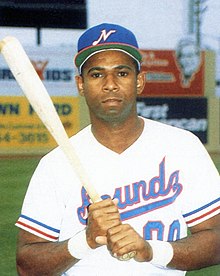
Skeeter Barnes played in 514 games for the Sounds, more than any other player in team history.
The Nashville Sounds Minor League Baseball team has played in Nashville, Tennessee, since its establishment in 1978. Through the completion of the 2023 season, 1,517 players have competed in at least one regular-season game for the Sounds. Of those, 1,095 have also played in at least one game for a Major League Baseball (MLB) team. Six additional players have appeared for the Sounds only in postseason games, one of whom has also played in the majors. Encompassing both regular and postseason play, 1,523 players have competed for Nashville; 1,096 of those have also played in Major League Baseball.
Created as an expansion team of the Double-A Southern League in 1978, the Sounds played in this league through 1984. At the Double-A classification, Nashville was affiliated with Major League Baseball's Cincinnati Reds (1978–1979) and New York Yankees (1980–1984). The Sounds moved up to Triple-A in 1985 as members of the American Association before joining the Pacific Coast League in 1998. With the restructuring of the minor leagues in 2021, they were placed in the Triple-A East, which became the International League in 2022. At this level, they have been affiliates of the Detroit Tigers (1985–1986), Cincinnati Reds (1987–1992), Chicago White Sox (1993–1997), Pittsburgh Pirates (1998–2004), Milwaukee Brewers (2005–2014), Oakland Athletics (2015–2018), and Texas Rangers (2019–2020). The Sounds reaffiliated with the Milwaukee Brewers in 2021. (Full article...) -
Image 8

Evan Longoria (2008) is the only Rays' first-round pick to win a Rookie of the Year Award with the team.
The Tampa Bay Rays are a Major League Baseball franchise based in St. Petersburg, Florida. The Rays (formerly the Tampa Bay Devil Rays) compete in the American League East division. Since the franchise was established in 1995, the Rays have selected 36 players in the first round. Officially known as the "First-Year Player Draft", the Rule 4 Draft is Major League Baseball's primary mechanism for assigning amateur baseball players from high schools, colleges, and other amateur baseball clubs to its teams. The draft order is determined based on the previous season's standings, with the team possessing the worst record receiving the first pick. In addition, teams which lost free agents in the previous off-season may be awarded compensatory or supplementary picks. The First-Year Player Draft is unrelated to the 1997 expansion draft in which the Rays filled their roster.
Of the 36 players the Rays have selected in the first round, 10 have been outfielders and 12 have been drafted exclusively as pitchers. Of the 12 pitchers, eight were right-handed and four were left-handed. The Rays have also drafted five shortstops, four third basemen, two catchers, one second baseman, and one first baseman. In addition to these, one player (2017 pick Brendan McKay) was drafted as both a left-handed pitcher and a first baseman. Twenty players were drafted out of high school, 12 were drafted out of four-year colleges, and one was drafted from a junior college. Two players were drafted from Rice University in Houston, Texas in consecutive years. (Full article...) -
Image 9
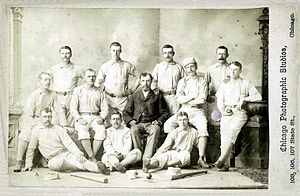
1882 Providence Grays
The Providence Grays were a Major League Baseball franchise based in Providence, Rhode Island from 1878 to 1885. During the team's eight seasons in the National League (NL), which then comprised eight teams, they finished third place or higher in the final standings seven times, and won the league championship in both 1879 and 1884. Providence played their home games at the Messer Street Grounds, which was located in the Olneyville neighborhood of Providence. The Grays were officially organized on January 16, 1878 by Benjamin Douglas, who became the team's general manager. Henry Root was hired as the team president‚ and Tom Carey was initially hired to be the on-field captain, whose duties were similar to the modern-day manager. On January 21, 1878, Providence applied for membership in the NL, and was officially approved on February 6. On April 10, Root took over ownership of the team, fired Douglas for incompetence and insubordination, and hired Tom York to replace Carey as captain.
Providence was successful in signing several star players for their inaugural season: Paul Hines had played the previous four seasons with the Chicago White Stockings; Tom Carey was signed after the Hartford Dark Blues folded; Doug Allison was the catcher for the 1869 Cincinnati Red Stockings, who had an 84-game winning streak from 1869 to 1870; and John Montgomery Ward, who was playing his first season in the major leagues. Ward had a win–loss record of 22–13 and Hines led the league in home runs, runs batted in (RBIs), and batting average as the Grays finished in third place among the six teams in the NL for the 1878 season, with a record of 33 wins, 27 losses, and 2 ties. The Grays won the NL championship in 1879, placing first among the league's eight teams with Ward winning 47 games as their starting pitcher, and the leadership of George Wright, who played second base and also managed. The team had a strong hitting line-up with Hines' league leading .357 batting average, as well as new additions Jim O'Rourke and Joe Start, who both had batting averages over .300. William Edward White, a Brown University player who played one game for the Grays on June 21, 1879, may have been the first African-American to play at the major league level; according to Peter Morris of the Society for American Baseball Research, the evidence for White is strong, but not conclusive. If this claim is true, then White pre-dated both Moses Fleetwood Walker and his brother Weldy Walker, who both played for the 1884 Toledo Blue Stockings of the American Association (AA). In 1880, the Grays finished in second place among the eight NL teams, with Ward winning 39 games. On June 17 of that year, Ward pitched the second perfect game in major league history. (Full article...) -
Image 10

Clayton Kershaw holds the Dodgers' record for most Opening Day starts with nine (2011–2018 & 2021).
The Los Angeles Dodgers are a Major League Baseball (MLB) franchise based in Los Angeles. They play in the National League West division. The first game of the new baseball season for a team is played on Opening Day, and being named the Opening Day starter is an honor, which is often given to the player who is expected to lead the pitching staff that season, though there are various strategic reasons why a team's best pitcher might not start on Opening Day. The Dodgers have used 26 different Opening Day starting pitchers in their 67 seasons in Los Angeles. The 26 starters have a combined Opening Day record of 29 wins, 27 losses and 10 no decisions.
The Dodgers started playing in Los Angeles in 1958, after moving from Brooklyn. The first Opening Day game for the Dodgers in Los Angeles was played in San Francisco against the San Francisco Giants on April 15, 1958. California native Don Drysdale was the Dodgers' Opening Day starting pitcher that day, in a game the Dodgers lost 8–0. Dodgers starting pitchers won both of their Opening Day starts in their first home ballpark in Los Angeles, Los Angeles Memorial Coliseum. (Full article...) -
Image 11

Robin Yount (1973) is one of two Brewers first-round picks to be inducted in the National Baseball Hall of Fame.
The Milwaukee Brewers are a Major League Baseball (MLB) franchise based in Milwaukee, Wisconsin. They play in the National League Central division. Established in Seattle, Washington, as the Seattle Pilots in 1969, the team became the Milwaukee Brewers after relocating to Milwaukee in 1970. The franchise played in the American League until 1998, when it moved to the National League in conjunction with a major league realignment. Since the institution of MLB's Rule 4 draft, the Brewers have selected 69 players in the first round. Officially known as the "First-Year Player Draft", the Rule 4 draft is MLB's primary mechanism for assigning players from high schools, colleges, and other amateur clubs to its franchises. The draft order is determined based on the previous season's standings, with the team possessing the worst record receiving the first pick. In addition, teams which lost free agents in the previous off-season may be awarded compensatory or supplementary picks.
Of the 71 players picked in the first round by Milwaukee, 28 have been pitchers, the most of any position; 18 of these were right-handed, while 10 were left-handed. Fifteen outfielders, 13 shortstops, 5 third basemen, 4 first basemen, 3 catchers, and 3 second basemen were also taken. Fifteen of the players came from high schools or universities in the state of California, and Florida follows with ten players. (Full article...) -
Image 12
Aaron Cook, the 2007 Opening Day starter
The Colorado Rockies are a Major League Baseball (MLB) franchise based in Denver, Colorado. They play in the National League West division. The first game of the new baseball season for a team is played on Opening Day, and being named the Opening Day starter is an honor, which is often given to the player who is expected to lead the pitching staff that season, though there are various strategic reasons why a team's best pitcher might not start on Opening Day. The Rockies have used 20 different Opening Day starting pitchers in their 28 seasons. Since the Rockies' first season in 1993, the 20 starters have a combined Opening Day record of eleven wins, nine losses (11–9), and eight no decisions. No decisions are only awarded to the starting pitcher if the game is won or lost after the starting pitcher has left the game.
Eight Rockies pitchers have started on two Opening Days: Kevin Ritz, Darryl Kile, Mike Hampton, Jason Jennings, Aaron Cook, Ubaldo Jiménez, Jorge de la Rosa, and Jon Gray. Kile has the best Opening Day record with two wins and no losses. Armando Reynoso is the only Rockies pitcher to start on Opening Day in Colorado's former home of Mile High Stadium. Rockies starting pitchers have an Opening Day record of four wins, two losses, and one no decision when at home. With the exception of one lost game at Mile High Stadium, the other games were played at Colorado's current home stadium of Coors Field. On the road for Opening Day, Colorado starting pitchers have accumulated a record of seven wins, seven losses, and seven no decisions. The Rockies have a record of two wins and three losses on Opening Day for seasons in which they would later go on to participate in post-season play. (Full article...) -
Image 13

Mariano Rivera has the most career saves in Major League Baseball history with 652.
In Major League Baseball (MLB), the 300 save club is the group of pitchers who have recorded 300 or more regular-season saves in their careers. Most commonly a relief pitcher ("reliever" or "closer") earns a save by being the final pitcher of a game in which his team is winning by three or fewer runs and pitching at least one inning without losing the lead. The final pitcher of a game can earn a save by getting at least one batter out to end the game with the tying run on base, at bat, or on deck, or by pitching the last three innings without relinquishing the lead, regardless of score.
The statistic was created by Jerome Holtzman in 1959 to "measure the effectiveness of relief pitchers" and was adopted as an official statistic by MLB in 1969. The save has been retroactively measured for past pitchers where applicable. Hoyt Wilhelm retired in 1972 and recorded just 31 saves from 1969 onwards, for example, but holds 228 total career saves.
Mariano Rivera holds the MLB save record with 652. Only Rivera and Trevor Hoffman have exceeded 500 or 600 saves, and Hoffman was the first to achieve either. Only eight pitchers have recorded 400 or more saves: Rivera, Hoffman, Lee Smith, Kenley Jansen, Craig Kimbrel, Francisco Rodríguez, John Franco, and Billy Wagner. (Full article...) -
Image 14
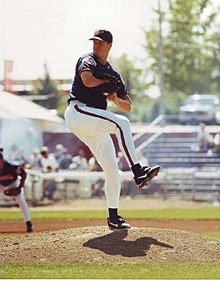
Jim Abbott (1988), born without a right hand, won the 1987 Golden Spikes Award, the 1992 Tony Conigliaro Award, and the 1995 Hutch Award.
The Los Angeles Angels are a Major League Baseball (MLB) franchise based in Anaheim, California. They play in the American League (AL) West division. Since the institution of Major League Baseball's Rule 4 Draft in 1965, the Angels have selected 62 players in the first round. Officially known as the "First-Year Player Draft", the Rule 4 Draft is Major League Baseball's primary mechanism for assigning amateur players from high schools, colleges, and other amateur clubs to its teams. The draft order is determined based on the previous season's standings, with the team possessing the worst record receiving the first pick. In addition, teams which lost free agents in the previous off-season may be awarded compensatory or supplementary picks.
Of the 66 players drafted by the Angels, 29 have been pitchers, the most of any position; 18 of these were right-handed, while 11 were left-handed. Fourteen outfielders, eight shortstops, four third basemen, and four first basemen were also taken. No second basemen have been selected. Thirteen of the players came from high schools or universities in the state of California, while Florida follows with six players. Four players have been selected from both Illinois and Georgia. All players selected have been from the United States. The franchise has made five selections in the same draft three times, in 1986, 2009, and 2010. (Full article...) -
Image 15
Major League Baseball (MLB) annually honors its best relief pitchers in the American League (AL) and National League (NL) with the Mariano Rivera AL Reliever of the Year Award and Trevor Hoffman NL Reliever of the Year Award, respectively. The awards are named after former relievers Mariano Rivera and Trevor Hoffman, who played their entire careers in the respective leagues. First issued in 2014, the awards replaced the Delivery Man of the Year Award, which had been presented since 2005.
The Reliever of the Year Awards are based on the votes of a panel of retired relievers. Each voter selects three pitchers for each league based solely on their performance in the regular season; a 5-3-1 weighted point system is used to determine the winner. At its inception in 2014, the panel consisted of the top five relievers in career saves at the time—Rivera, Hoffman, Lee Smith, John Franco, and Billy Wagner—and the four living relief pitchers who were in the Hall of Fame: Dennis Eckersley, Rollie Fingers, Goose Gossage, and Bruce Sutter. (Full article...)
More did you know
- ... that baseball Hall of Famer Rogers Hornsby had his first plate appearance against King Lear?
- ... that the Philadelphia Phillies were the last of the original 16 Major League Baseball franchises to win the World Series?
- ... that Harry Blackmun's colleagues on the U.S. Supreme Court felt his long history of baseball in the Flood v. Kuhn majority opinion was beneath the Court's dignity?
- ... that the Danville 97s minor league baseball team name of 97s was selected as a tribute to the victims of the Wreck of the Old 97 train accident?
- ... that Frank Graham called Dave Bancroft "the greatest shortstop the Giants ever had and one of the greatest that ever lived"?
Sports portals
Selected picture

| Credit: Rick Dikeman |
The pitching motion of Major League pitcher Brandon Claussen, playing for the Cincinnati Reds in 2004.
Associated Wikimedia
The following Wikimedia Foundation sister projects provide more on this subject:
-
Commons
Free media repository -
Wikibooks
Free textbooks and manuals -
Wikidata
Free knowledge base -
Wikinews
Free-content news -
Wikiquote
Collection of quotations -
Wikisource
Free-content library -
Wikiversity
Free learning tools -
Wiktionary
Dictionary and thesaurus
More portals
- Pages using the Phonos extension
- Pages including recorded pronunciations
- Pages with Spanish IPA
- Portals with triaged subpages from June 2018
- All portals with triaged subpages
- Portals with no named maintainer
- Automated article-slideshow portals with 51–100 articles in article list
- Automated article-slideshow portals with 501–1000 articles in article list
- Random portal component with 41–50 available subpages
- Automated article-slideshow portals with 201–500 articles in article list
- Random portal component with 11–15 available subpages
- Random portal component with 21–25 available image subpages






